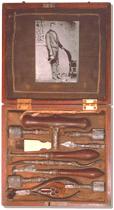Seventeenth century skull trepanation set

|
Silk and velvet dressing (5x20,5x18,5cm).
Attached photograph of its prior owner.
Four trephine crowns: steel; 2x7,2x2cm and 2x7,5x2cm
Trephine handle: wood and steel; 6x13x2,5cm
Rougine and lenticular knife: wood and steel; 2,5x17,5x2,5cm;
Perforator: steel; 0,4x8,5x1,4cm
Tweezer: steel; 4x13,5x4cm
Double elevator: steel; 1,5x17x4cm
Brush: ivory and bristle; 1x7x2,1cm
Key: steel; 0,6x4x1,7cm
Wood, ivory, bristle, steel, brass and cloth; 18th century |
Skull trepanation is dated to the Neolithic period, when man used a carved piece of mineral as an instrument. It might have been used sometimes in the Egyptian Civilization. Although quoted in the
"Corpus Hipocraticum" its use was really rare. The instrument used might have been the trepan tree, probably made of iron with an organic material handle. About this instrument António de Almeida explains, in
"Tratado Completo de Medicina Operatória" ("Complete Textbook of Operating Medicine"), vol. I, page 57, note 1:
"The trepan is an instrument made of several parts which are the tree, the crown, the perforator and the scraper. These last pieces are connected to the tree by means of a socket with spring that holds them in position, so that they can be used to their various purposes. The Trepan is so old that it was already used in Hippocrates era, and it was unique as a device that has come so complete from its origin that no adjustments needed to be made. The English use a skull trephine instead of the trepan, and cylindrical crowns instead of conical ones; however, the tree trepan works faster and the conical crown is safer since it cannot enter the cranial cavity even if all the internal lamina is accidentally cut. Besides the pyramid, that is taken off and put back in the center of the crown with the help of a key, there are other accessory instruments such as the elevators, the bone scrapers, the gouges, the button knife, the little brush, the cutting pincers, etc., which can be more easily understood by seeing than by hearing about."
It was mainly through Flemish painting of the 16th and 17th centuries that a scene of a skull trepanation could be visualized, with evidence to the position and expression of the patient, the position of the surgeon and his assistants, the technique and the instruments used. It was about the belief in the
"Madness Stone" and the solution to this charlatanism was a skull trepanation. Berengario de Carpo (1518) made the first detailed description of the trepan. In the 17th century J. Scultetus in his
"Armamentarium Chirurgicum" (1655), in the 18th century Heister in
"A General System of Surgery" (1845), and in the next century Sir Charles Bell in
"Illustrations of the great operations of surgery" (1821) and J. M. Bourgery and N. H. Jacob in
"Traité Complet de l'Anatomie de l'Homme Comprenant la Médicine Opératoire" ("Complete Textbook of Human Anatomy Including Operating Medicine") (1837- 40), present images of a skull trepanation surgical scene, as well as the necessary surgical instruments which shapes and compositions are enhanced.
According to António de Almeida the chosen 17th century skull trepanation set, although without any manufacturer marks, has probably an English origin, considering the shape of the surgical instruments (gimlet handle and cylindrical trephine crowns).
In the period prior to the antisepsis/asepsis the instruments were continuously used in the patients without any concern with sterilization. If there was any instrument cleansing it was due to proper care and performance of the instrument itself. So, there was no obstacle to the inclusion of organic materials in the manufacture of such devices. The technological level and the scientific and technical demands of those times determined the use of ferrous and non-ferrous metals, which were then available.



